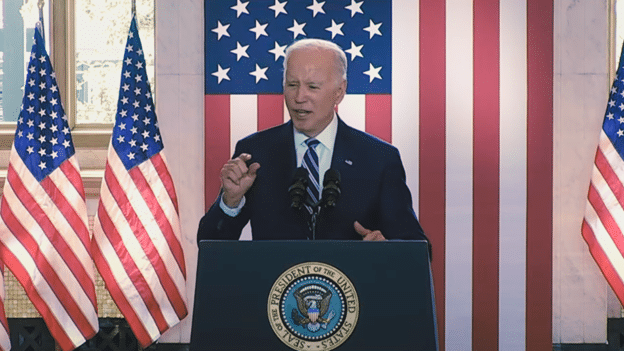
Consumer inflation reversed course slightly in June as overall prices fell by 0.1 percent, led by drops in gasoline and other energy products, according to the latest data compiled by the Bureau of Labor Statistics.
But it might be a situation of too little, too late for President Joe Biden who faces reelection this year against former President Donald Trump, as personal incomes have still not caught up to prices.
In fact, consumer prices have increased 18.76 percent since Feb. 2021, while personal incomes including government transfer payments compiled by the Bureau of Economic Analysis are still only up 18.1 percent in that same time period, a proverbial stake through the heart of Americans’ household budgets. Prices are still much higher than before the pandemic.
In the meantime, consumer credit has slowed down significantly, from an annual growth rate of 9.9 percent in April 2022 all the way down to 2 percent in May 2024.
This is what happens when inflation washes over the economy — juiced by the almost $7 trillion that was printed, borrowed and spent into existence by the Federal Reserve and Congress in response to Covid — that is, when you increase the monetary base and give people helicopter money, yes, their incomes will increase temporarily, but so will prices.
Whatever justification in 2020 there was for boosting aggregate demand with government spending — with state and local government economic lockdowns including school closures amid pandemic worries and unemployment temporarily increasing with 25 million jobs lost — by 2021, much of the emergency was over. 16 million out the 25 million jobs had already been recovered as states and cities eased the Covid restrictions.
That’s cause and effect. And it was absolutely on purpose. During the pandemic, the economy was on its back as prices were collapsing, including oil prices that dropped below zero dollars. The normal supply chain got backed up as demand collapsed to depression-like levels. The available offset was for the government to spend money — but how much was enough?
In May of 2020, inflation was at a low of 0.2 percent amid the lockdowns, but after the government spending including the $2.2 trillion CARES Act, by Jan. 2021, some semblance of normalcy had resumed, with inflation back towards 1.4 percent.
But Biden, then the newly elected President, kept right on going, pushing another $1.9 trillion economic stimulus through Congress that included another series of checks to households, plus another $891 billion of green energy subsidies, with predictable results: By Jan. 2022, right before Russia’s full-scale invasion of Ukraine, inflation had already reached 7.5 percent, and afterward, would peak at 9.1 percent in June 2022.
All the while, the Federal Reserve saw no problems and kept its own interest rates at near-zero percent levels, only acting to raise interest rates after the war in Ukraine had expanded and already taxed global supply chains were further disrupted. By then, the inflation cake was already baked.
After high inflation, the economy tends to overheat, consumer spending slows down as credit cards are maxed out and, then, the unemployment rate tends to rise — which it has, from its low of 3.4 percent in April 2023 and now up to 4.1 percent in June, with 1.1 million more unemployed since Dec. 2022. In other words, we’re well past peak employment.
And that is the record Biden — or whoever replaces him — will have to take to voters in 2024. With prices outpacing incomes and their credit reaching the max with high interest rates, they are significantly worse off than they were four years ago. And no amount of window dressing between now and November will likely change that.
Robert Romano is the Vice President of Public Policy at Americans for Limited Government Foundation.






